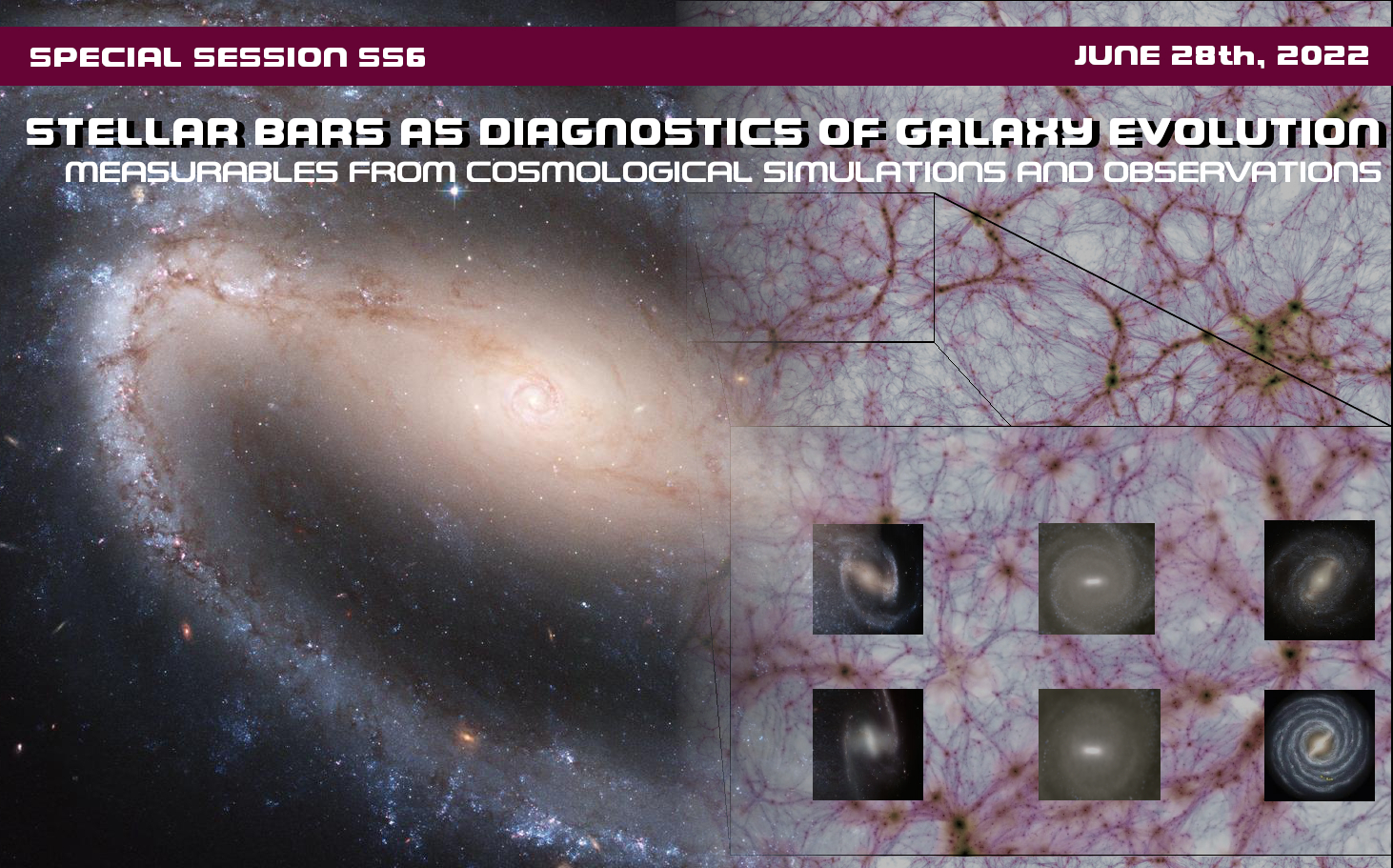Special Session SS6
28 June 2022
Stellar bars as diagnostics of galaxy evolution: measurables from cosmological simulations and observations

Aims and scope
Stellar bars are a common structure (>60%) in local spiral galaxies. These structures are believed to form at redshifts 1-2 and are considered the main drivers of galaxy secular evolution. Stellar bars present a variety of morphologies and sizes, from few to tens of kpc in size. Our own Milky Way hosts a stellar bar whose characteristics are still debated.
After many decades of studying barred galaxies with limiting spatial resolution, we are entering in an exciting era: both zoom-in cosmological hydrodynamic simulations of a Milky-Way-like galaxy (Eris, NIHAO, AURIGA, etc) and those of a galaxy population (Illustris, Eagle, HorizonAGN, etc) are starting to resolve bars, while new instrumentation and telescopes are allowing us to dissect farther and farther galaxies, down to very small spatial scales. In addition, Gaia, GALAH, and Apogee are already providing key information to discern the structure and properties of our own stellar bar. The immediate future, with JWST, ELTs, IllustrisTNG, NewHorizon? foretells revolutionising results about stellar bars. We must be prepared for the avalanche of new information that is coming.
In this Special Session, we aim at bringing together the community studying stellar bars, particularly early-stage researchers who will have the leading role in the revolution to come. Almost a decade has passed since the latest conference on stellar bars, and the advent of cosmological simulations where bars are resolved has not been discussed yet. We will have two very-focused sessions to discuss what specific properties we can measure in observations and what they tell us about galaxy evolution, and what specific properties we can measure in new cosmological simulations and what they tell us about galaxy evolution. In each session, we will discuss the expectations for the immediate future (next decade) from new-generation telescopes, instruments, and simulations.
Selection process and gender statistics
We have received 24 abstracts for oral contributions, meaning an oversubscription factor of 3; 54% of the authors are female and 46% are male.
Due to the fact that SS6 is divided into two slots, the abstracts were classified accordingly. To minimise any kind of bias such as gender and academic career during the process, the SOC rated the abstracts blindfolded and anonymously with the help of digital tools, with the exception of one of the co-chairs who gathered the data and organised the process. Following EAS guidelines, each abstract was given a score from 0 (misplaced) to 5 (excellent).
Those abstracts with mean scores equal to or greater than 4 were selected, resulting in a final statistic of 50% female and 50% male authors.
Programme
- Session 1: Observational properties of stellar bars: what do they tell us about particular stages of galaxy evolution?, June 28th, 11.15-12.45
11.15 Presentation: Yetli Rosas-Guevara and Adriana de Lorenzo-Cáceres
11.20 Invited talk: Bars in galaxies: observational perspectives, Sandor Kruk (MPE/ ESA)
11.44 Contributed talk: All bar none: characterization of the effect of bars on their host galaxies, Amelia Fraser McKelvie (University of Western Australia)
11.58 Contributed talk: Stellar populations of galaxy bars in the MUSE TIMER project, Justus Neumann (University of Portsmouth)
12.12 Contributed talk: Central star formation and the inside-out growth of nuclear discs: estimating the ages of bars, Camila de Sa Freitas (ESO)
12.26 Contributed talk: Stellar bar effect on gas-phase abundance gradients, Almudena Zurita (Universidad de Granada)
- Session 2: Stellar bars as a constraint to sub-grid physics modelling in cosmological hydrodynamic simulations, June 28th, 17.30-19.00
17.30 Invited talk: Constraining galaxy formation and evolution with galactic bars, Francesca Fragkoudi (ESO / Durham University)
17.54 Contributed talk: The effects of AGN feedback on the bars and bulges of Milky Way-mass galaxies in cosmological simulations, Dimitrios Irodotou (University of Helsinki)
18.08 Contributed talk: Barred galaxies in TNG50: automatic kinematic decomposition with MORDOR, Tommaso Zana (Scuola Normale Superiore)
18.22 Contributed talk: Hints of Dark Matter Distribution in Disk Galaxies from Bar Buckling, Ankit Kumar (Indian Institute of Astrophysics)
18.36 Contributed talk: Stellar radial migration from bars, Anaelle Halle (Paris Observatory)
18.50 Concluding remarks: Dimitri Gadotti (On behalf of the SOC)
Scientific organisers
Yetli Rosas-Guevara (co-chair, DIPC), Adriana de Lorenzo-Cáceres (co-chair, IAC),
Silvia Bonoli (DIPC), Dimitri Gadotti (ESO/ Durham University), Marie Martig (Liverpool John Moores University), Jairo Méndez-Abreu (IAC/ La Laguna University)
Contact
EAS2022.SS06 @ gmail.com
Updated on Wed Jun 15 15:17:36 CEST 2022
|